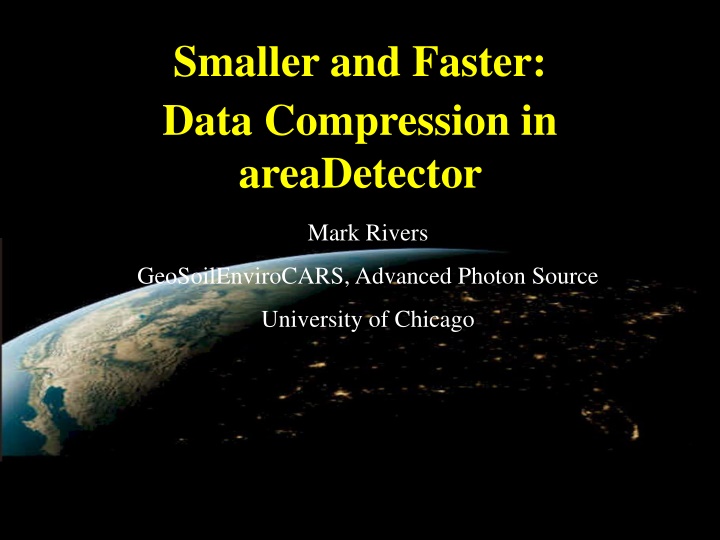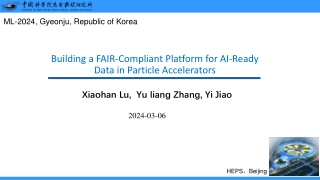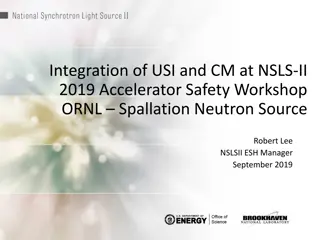
Enhancing Data Compression Techniques for Advanced Detectors
Explore the latest advancements in data compression for cutting-edge detectors such as Eiger, Pilatus, and more at the Advanced Photon Source University of Chicago. Learn about new features, support for GenICam cameras, and how compression helps manage big data challenges efficiently.
Uploaded on | 1 Views
Download Presentation

Please find below an Image/Link to download the presentation.
The content on the website is provided AS IS for your information and personal use only. It may not be sold, licensed, or shared on other websites without obtaining consent from the author. If you encounter any issues during the download, it is possible that the publisher has removed the file from their server.
You are allowed to download the files provided on this website for personal or commercial use, subject to the condition that they are used lawfully. All files are the property of their respective owners.
The content on the website is provided AS IS for your information and personal use only. It may not be sold, licensed, or shared on other websites without obtaining consent from the author.
E N D
Presentation Transcript
Smaller and Faster: Data Compression in areaDetector Mark Rivers GeoSoilEnviroCARS, Advanced Photon Source University of Chicago
Outline Last talk at NSLS-II was May 2018 ADCore releases since then: R3-4, R3-5, R3-6 (soon) This talk: New data compression features Demo of data compression Other major features from these releases Second talk: Enhanced Support for GenICam Cameras and Detectors
Data Compression Motivation We are already in the era of big data with existing detectors. Eiger, Pilatus, Lambda, PCO, FLIR/Point Grey, Xspress 3, etc. Can all produce data faster than most disk systems can handle All exceed 1 Gbit network capacity, and some exceed 10 Gbit. Rapidly fill up disks Will become a more serious issue with coming upgrades Increased count rates will allow existing detectors to run at their maximum speed New generations of even faster detectors will be coming Data compression can help with these issues Must be fast and easy to use
Support for Compressed NDArrays and NTNDArrays NDArray has 2 new fields to support compression .codec field (struct Codec_t) to describe the compressor typedef enum { NDCODEC_NONE, NDCODEC_JPEG, NDCODEC_BLOSC, NDCODEC_LZ4, NDCODEC_BSLZ4 } NDCodecCompressor_t; typedef struct Codec_t { std::string name; /**< Name of the codec */ int level; /**< Compression level. */ int shuffle; /**< Shuffle type. */ int compressor; /**< Compressor type */ .compressedSize (size_t) field with compressed size if codec.name is not empty. pvAccess NTNDArray has always had .compressedSize and .codec fields, but never previously implemented in servers or clients
NDPluginCodec (R3-4) New plugin for data compression and decompression Written by Bruno Martins from FRIB Mode: Compress or Decompress Compressor: None JPEG (JPEGQuality selection) Blosc (many options, next slide) LZ4 BSLZ4 (Bitshuffle/lz4) CompFactor_RBV: Actual compression ratio CodecStatus, CodecError JPEG is lossy, all others lossless
Blosc Codec Options BloscCompressor options. Each has different compression performance and speed BloscLZ LZ4 LZ4HC Snappy Zlib Zstd BloscCLevel Compression level: 0=no compression, 9=maximum compression. Increasing execution time with increasing level. BloscShuffle Choices = None, Byte, Bit. Differences in speed and compression performance. BloscNumThreads Number of threads used to compress each NDArray
LZ4 and BSLZ4 Codecs These are the codecs used by the Eiger server from Dectris They don t use the Blosc codecs, but rather the native LZ4 and Bitshuffle/LZ4 codecs. Dectris server can optionally use these compressions for HDF5 files saved locally on their server Dectris server always uses one of these compressions for data streamed over the ZeroMQ socket interface to the ADEiger driver These can now be decoded directly in ADEiger, or passed as compressed NDArrays to NDPluginCodec and other plugins Compressed arrays can be passed directly to NDFileHDF5 to be written with newly supported direct chunk write feature. More on this later.
Codec Parameter Records (R3-5) Codec_RBV and CompressedSize_RBV records to asynNDArrayDriver and hence to all plugins.
HDF5 Changes (R3-5) NDFileHDF5 file writing plugin has always supported the built-in compression filters from HDF5: N-bit SZIP ZLIB R3-3 added support for Blosc filters New support for LZ4, Bitshuffle/LZ4, and JPEG filters All of these compressors are called from the HDF5 library. Limits performance because of the overhead of the library. New support for HDF5 Direct Chunk Write The NDArrays can be pre-compressed, either in NDPluginCodec, or directly by the driver (e.g. ADEiger) Much faster, much of the code in the HDF5 library is skipped. Fixed a number of memory leaks, some were significant Added FlushNow record to force flushing datasets to disk in SWMR mode
HDF5 Direct Chunk Write Performance 1024x1024 32-bit images simDetector generating ~1350 frames/s = 5.4 GB/s. Blosc LZ4 ByteShuffle compression Compression level 6. NDPluginCodec 6 Blosc threads 3 plugin threads. Compression factor is ~64 Time to save a single HDF5 file with 10,000 frames. No compression NDFileHDF5 compression NDPluginCodec compression, direct chunk write 650 7.4 1,351 5,405 88 File size (MB) Total time (s) Frame/s MB/s uncompressed MB/s compressed 40,000 106 94 389 N.A. 650 32 312 1,250 20 HDF5 library can only compress 312 frames/s NDPluginCodec & direct chunk write keeps up with simDetector 1,350 frames/s
HDF5 Decompression Plugin Filters (ADSupport R1-7) HDF5 supports dynamic loading of compression and decompression filter libraries at run time. The Blosc, LZ4, BSLZ4, and JPEG compressors have been built into the HDF5 library in ADSupport so that dynamic loading is not required when using NDFileHDF5. However, to decompress HDF5 files compressed with Blosc, LZ4, BSLZ4, or JPEG with other applications dynamic loading of the filters will be required ADSupport now builds these dynamic filter libraries for Linux, Windows, and Mac. Must set the following environment variable to use them: HDF5_PLUGIN_PATH=[areaDetector]/ADSupport/lib/linux-x86_64
HDF5 Decompression Plugin Filters >h5dump --properties test_hdf5_direct_chunk_3.h5 HDF5 "test_hdf5_direct_chunk_3.h5" { GROUP "/" { GROUP "entry" { DATASET "data" { DATATYPE H5T_STD_U32LE DATASPACE SIMPLE { ( 100, 1024, 1024 ) / ( 100, 1024, 1024 ) } STORAGE_LAYOUT { CHUNKED ( 1, 1024, 1024 ) SIZE 4082368 (102.742:1 COMPRESSION) } FILTERS { USER_DEFINED_FILTER { FILTER_ID 32001 COMMENT blosc PARAMS { 2 2 4 4194304 8 1 1 } } } DATA { (0,0,0): 173140, 173141, 173142, 173143, 173144, 173145, 173146, (0,0,7): 173147, 173148, 173149, 173150, 173151, 173152, 173153, (0,0,14): 173154, 173155, 173156, 173157, 173158, 173159, 173160, (0,0,21): 173161, 173162, 173163, 173164, 173165, 173166, 173167,
ImageJ pvAccess Viewer Now supports displaying compressed NTNDArrays Supports all compressions (JPEG, Blosc, LZ4, BSLZ4) Can greatly reduce network bandwidth when the IOC and viewer are running on different machines No compression Blosc compression
ADEiger Changes Now supports Bitshuffle/LZ4 on Stream interface over ZeroMQ Previously only LZ4 was supported New StreamDecompress bo record to enable/disable decompression. If disabled: NDFileHDF5 can use Direct Chunk Write without ever decompressing NDPluginPva can send to ImageJ without ever decompressing NDPluginCodec can decompress for other plugins like NDPluginStats, etc.
Compression Demonstration Running simDetector on Linux machine Running medm and ImageJ on a Windows machine in my office Connected to Linux machine with 1 Gbit Ethernet Displaying here with VNC
Improvements in ADCore (R3-4) New MaxByteRate record for plugins to limit output rate For most plugins this limits the byte rate of the NDArrays passed to downstream plugins For NDPluginStdArrays it limits the byte rate of the data callbacks to waveform records, and hence to Channel Access clients For NDPluginPva it limits the byte rate of the data callbacks to pvAccess clients Optimization improvement when output arrays are sorted. Previously it always put the array in the sort queue, even if the order of this array was OK. Introduced an unneeded latency because the sort task only runs periodically. Caused ImageJ update rates to be slow, because it made PVA output comes in bursts, and some arrays were dropped either in the pvAccess server or client. Now if the array is in the correct order it is output immediately.
Documentation Improvements (R3-5) Documentation was changed from manually edited HTML pages to reStructuredText (.rst) files processed with Spinx. Most tables are left in native HTML because .rst conversion is poor quality Server changed from https://cars.uchicago.edu/software/epics/ to areaDetector.github.io/ Advantages: Easier to edit Nicer looking pages New Travis CI job at top-level areaDetector Runs doxygen and sphinx to update the areaDetector.github.io files every time there is a push to the top-level areaDetector repository. Thanks to Stuart Wilkins from BNL who set up the process and converted all of the files in ADCore, ADProsilica, and ADFastCCD. Other detector repositories still need to be converted. Use pandoc to convert .html to .rst. Manual editing still required.
NDPluginAttribute Time Series (R3-5) Previously NDPluginAttribute time series code was internal Changed so that it now uses NDPluginTimeSeries, same change that was made to NDPluginStats in R3-5 Fewer lines of code, and adds Circular Buffer mode The time-series waveform PVs are the same The PVs to control the time-series (start/stop, # of points) have changed, so clients may need modifications


















